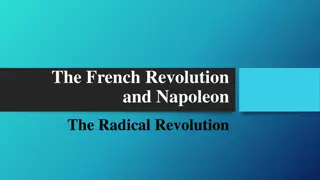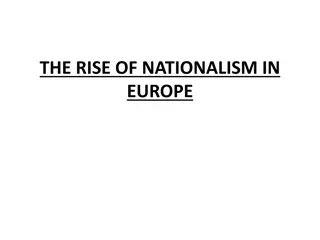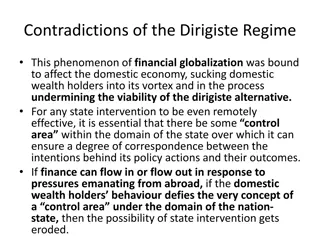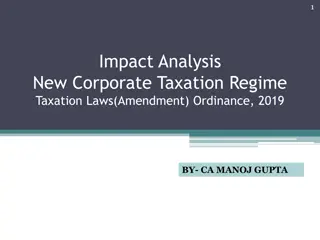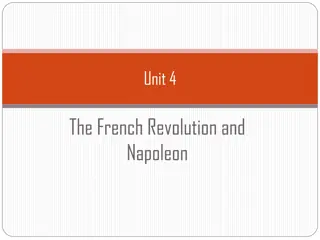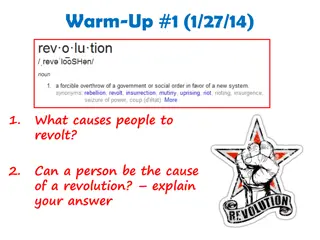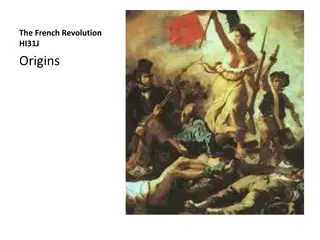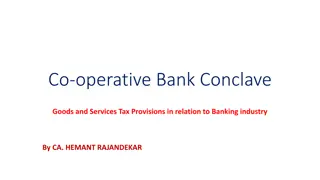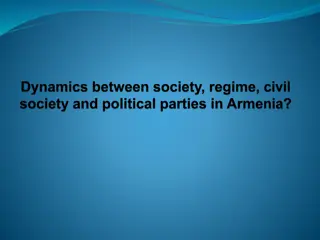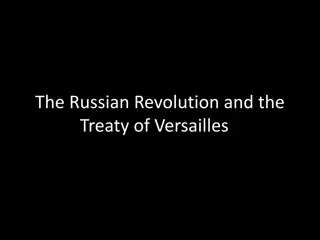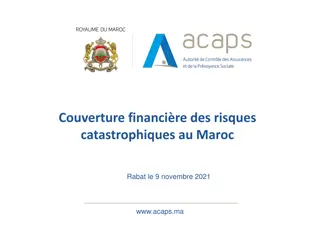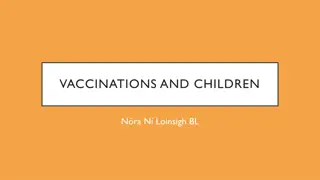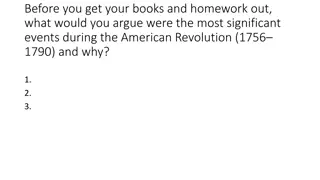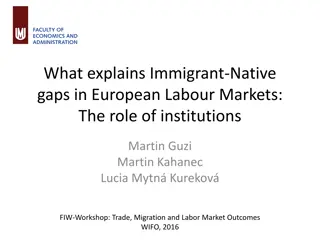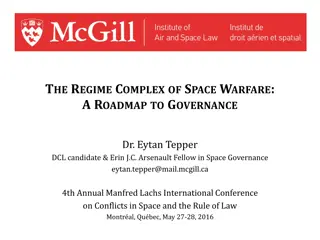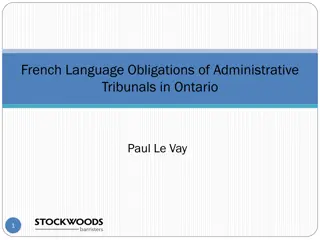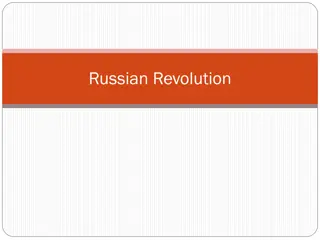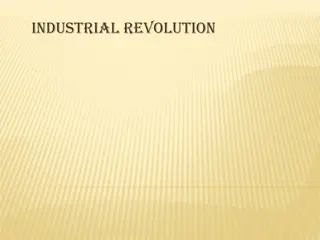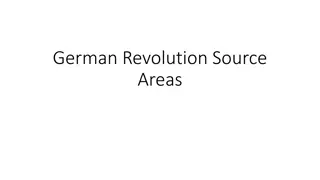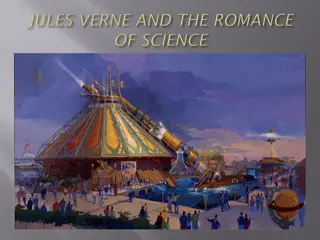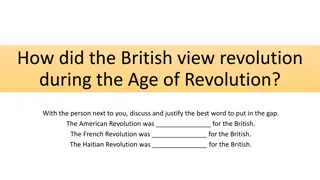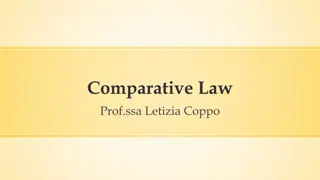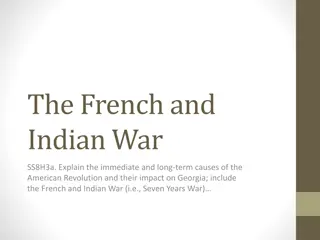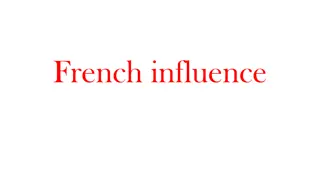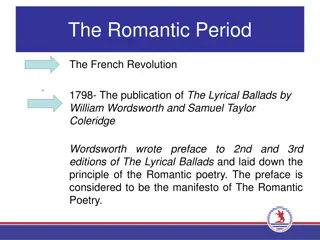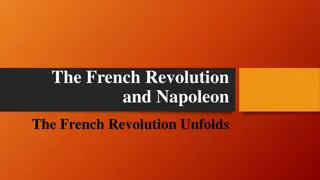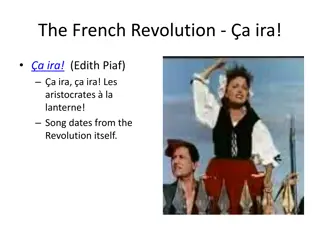Overview of the Old Regime and the French Revolution
The Old Regime in France before the French Revolution was marked by a hierarchical society divided into privileged and unprivileged classes. The monarchy held absolute power under the Divine Right of Kings, leading to economic hardships and discontent among the populace. King Louis XVI's lavish spending and inability to address financial crises ultimately contributed to the bankruptcy of France, setting the stage for the revolutionary period.
Download Presentation

Please find below an Image/Link to download the presentation.
The content on the website is provided AS IS for your information and personal use only. It may not be sold, licensed, or shared on other websites without obtaining consent from the author. Download presentation by click this link. If you encounter any issues during the download, it is possible that the publisher has removed the file from their server.
E N D
Presentation Transcript
The Old Regime (Ancient Regime) Old Regime: A socio-political system which existed in most of Europe during the 18thcentury. Countries were ruled by absolutism: the monarch had absolute control over the government. People were divided into classes: the privileged and unprivileged Unprivileged people: paid taxes and were treated badly. Privileged people: did not pay taxes and were treated well.
Society Under the Old Regime In France, people were divided into three estates: First Estate High-ranking members of the Church Privileged Class Second Estate Nobility Privileged Class Third Estate Everyone Else: This could include peasants in the countryside to wealthy bourgeoisie merchants in the cities. Unprivileged class
Government under the Old Regime: The Divine Right of Kings The Monarch was ruled by the Divine Right. God put the world in motion. God put some people in positions of power. Power is given by God. No one can question God. No one can question someone put in power by God. Questioning the monarchy was blasphemy because it meant they were questioning God.
What Powers did the King have? He appointed the Intendents, the petty tyrants who governed France s 30 districts. He appointed the people who collected his taxes and carried out his laws. He controlled justice by appointing judges. He controlled the military. He could imprison anyone at any time for any reason. Blank warrants for arrest were called lettres de cachet He levied all taxes and decided how to spend the money. He made all laws. He made decisions regarding war and peace.
Economic Conditions under the Old Regime France s economy was based primarily on agriculture. Peasant farmers of France bore the burden of taxation. Poor harvests meant that the peasants had trouble paying their regular taxes. They could not afford to have their taxes raised. The bourgeoisie often managed to gather wealth. But they were still upset that they paid taxes while nobles did not.
France went Bankrupt King Louis XVI lavished money amongst himself and residences such as Versailles. Queen Marie Antoinette was seen as a wasteful spender. The government found its funds depleted as a result of wars. Including the funding of the American Revolution. Deficit Spending: When the government is spending more money than it takes in from tax revenues. Privileged classes would not submit to being taxed.
Philosophy of the French Revolution: The Enlightenment (Age of Reason) Scientists during the Renaissance had discovered laws that govern the natural world. Intellectuals philosophes began to ask if natural laws also apply to human beings. Particularly to human institutions such as governments. Philosophes were secular in thinking they used reason and logic rather than faith, religion, and superstition to answer important questions. They used reason and logic to determine how governments were formed. They tried to figure out what logical, rational principles work to tie people to their governments. They questioned the divine right of kings.
Long-Term Causes of the French Revolution Everything previously discussed: Absolutism. Unjust socio-political system. (Old Regime) Poor harvests which left peasant farmers with little money for taxes. Influence of the Enlightenment philosophes. Also: Mercantilism: Restricted trade The influence of other successful revolutions. England s Glorious Revolution (1688-1689) The American Revolution (1775-1783)
Short-Term Causes of the French Revolution Bankruptcy: Caused by deficit spending. Financial ministers (Turgot, Necker, Calonne) proposed changes. But these were rejected. An Assembly of Notables voted down taxation for the nobility in 1787. Estates-General Louis XVI had no choice but to call for a meeting of the Estates-General to find a solution to the bankruptcy problem. All three estates had not met since 1614. This set in motion a series of events which resulted in the abolition of the monarchy and a completely new socio- political system for France. Great Fear Worst famine in memory. Hungry, impoverished peasants feared that nobles at Estates- General were seeking greater privileges. Attacks on nobles occurred throughout the country in 1789.
Tennis Court Oath The Third Estate declared itself to be the National Assembly. King Louis XVI responded by locking the Third Estate out of the meeting. The Third Estate relocated to a nearby tennis court where its members vowed to stay together and create a written constitution for France. On June 23, 1789, Louis XVI relented. He ordered the three estates to meet together as the National Assembly and vote, by population, on a constitution for France.
National Assembly (1789-1791) Louis XVI did not actually want a written constitution. When news of his plan to use military force against the National Assembly reached Paris, citizens supporting the National Assembly stormed the Bastille on July 14, 1789.
Uprising in Paris The people of Paris seized weapons from the Bastille: July 14, 1789 Parisians organized their own government which they called the Commune. Small groups called factions, competed to control the city of Paris. Uprising spread throughout France: Nobles were attacked. Records of feudal dues and owed taxes were destroyed. Many nobles fled the country and became known as migr s. Louis XVI was forced to fly the new tricolored flag of France.
Adieu, Versailles! The Parisian Commune feared that Louis XVI would have foreign troops invade France to put down the rebellion. Louis XVI s wife, Marie Antoinette, was the sister of the Austrian emperor. A group of women attacked Versailles on October 5, 1789. This forced the royal family to relocate to Paris along with the National Assembly. The royal family spent the next several years in the Tuileries Palace as virtual prisoners.
Abolishment of the Monarchy The Convention abolished the Monarchy. As long as the royal family lived, the monarchy could be restored. This put the royal couple on trial for treason. Convictions were a foregone conclusion. Louis XVI was guillotined on January 21, 1793. Marie Antoinette was guillotined on October 16, 1793. Their daughter, Marie-Th r se was allowed to go to Vienna in 1795. She could not become Queen because of Salic law, which did not allow females to succeed to the throne. Their son, Louis-Charles, AKA Louis XVII (lived 1785-1795), was beaten and mistreated until he died in prison.
Reign of Terror: September 5, 1793-July 27, 1794 Despite military successes, the Convention continued to face domestic problems. Danton and his Jacobin political party came to dominate French politics. Committee of Public Safety Headed by Danton (and later Robespierre). Those accused of treason were tried by the Committee s Revolutionary Tribunal. Approximately 15,000 people died on the guillotine. Including innovative thinkers like Olympe de Gouges and Madame Jeanne Roland. The guillotine became known as the National Razor .
End of the Reign of Terror Members of the Girondist political party tried to end the Reign of Terror initiated by the Jacobin political party. This opposition to the Committee of Public Safety caused many Girondists to be tried and executed for treason. Eventually, even Georges Danton wanted to end the executions. This resulted in Danton being tried and executed for treason.
End of the Reign of Terror contd. Maximilien Robespierre became leader of the Committee of Public Safety He continued executing people. The Convention came to blame Robespierre for the Reign of Terror. Thermidorean Reaction July 27, 1794: ended the Reign of Terror The Convention sent Robespierre and other members of the Committee of Public Safety to the guillotine. Robespierre was guillotined on July 28, 1794.




